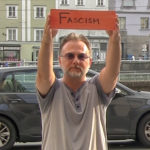
“Cash Cow”
Salzburg, Austria is known as a wealthy person’s playground, notably for its summer festival which include classical concerts and other forms of exclusive entertainment. The historic ‘old town’ is an area where most tourist mill around, sight-see and shop. However, Salzburg has a rich and fascinating history that often becomes overshadowed by picture perfect tourism.
Salzburg Architect Max Reider wrote,
“Once, somebody called Salzburg “Gesamtkunstwerk” (a fast‐selling item), or “cash‐cow”. Salzburg is a prototype for worth-living, medium‐sized town, heavily loaded by myth and history, expounding the future among tourism, thoughts symbolize a frozen city. In fact, the transformation still exists, quietly without concept and discussion. It is the reason, why I like to call it “theatre of city‐theatre”, an artificial fake. Salzburg is an example of the dead‐city, even though all transformations.”
Based on Benjamin’s essay One Way Street, a textual analysis was conducted of architecture, signage, and monuments west of the main rail station and north of old town. My study focused on the northern district of Lehen because most comments on websites about this area were negative. One website posted, “in terms of sightseeing, there is little to see in Lehen.” However, my study found this area to be one of the most diverse and multicultural areas with many important buildings and historical references. Additionally, near the central train station, a Memorial to the Victims of National Socialism rests in an easily overlooked area opposite the pedestrian square and bus stops. It is positioned well out of the direct line of sight of people exiting the station. In fact, it is doubtful anyone would recognize this memorial as anything of importance to the history of Salzburg.
Intervention
The intervention was performed around ‘Old Town’ and popular tourist areas like Mirabel Garden where most tourist focus their time. I displayed signage while simultaneously announcing important areas from Lehen and surrounding areas of Salzburg that are often overlooked by tourist yet have deep and meaningful historical relevance to the city. See examples below.









